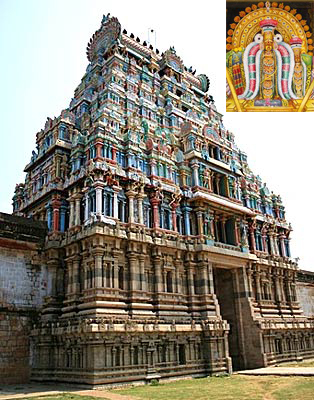Name of the Temple |
|
Location |
- Located in Thiruvārūr, near Thanjāvūr in Tamilnādu, South India.
|
| How to reach there? |
- By Air: The nearest airport is Thiruchirāpalli Airport which is about 110 km away. From the Thiruchirāpalli Airport take the National Highway 83 east to reach Thiruvārūr.
- By Train: The nearest railway station is Thiruvārūr Railway Station. It is 2 kms south of the temple.
- By Road: Thiruvārūr is connected by the State Highway 23 from Thiruthuraipūnḍi to Mayilāḍuthurai and 65 from Parappanaṅgaḍi to Puthalam and the National Highway 83 from Thanjāvūr to Nagapaṭṭinam.
|
Rulers/builders and Time Period |
- The temple dates back to the time of the Medieval Cholas though the existing temple complex as it exists today has been constructed only in the 14th century AD.
- There are plenty of inscriptions and paintings on the walls of the temple. The inscriptions either refer to the Medieval and Later Cholas or to the Thanjāvūr Marāthas.
- The temple complex seems to have acted as the cultural model for the big Bruhadīśhwara temple at Thanjāvūr of Rājarāja Chola I, wherein he enshrined a Vitankar which shared with the Āḍavallan of Chidambaram the status of state cult. The last Chola monarch to play an important role in the affairs of the temple was Kulotthunga Chola III in the early part of the 13th century A.D.
- It attracted Śhaivas of all schools and was important centre of Golaki matha in the 13th and 14th century. It was also an important Jaina dwelling place, which was attacked by Śhaivas, as is evident from Periya Purāṇam, in the account of the life of Tantiyaḍigaḷ.
|
Deity/Deities |
- Vālmīkināthar represents the Mūlavar while the shrine dedicated to Thyāgarāja is the better known shrine in the temple.
- Thyāgarāja (Somaskandha) image at Thiruvārūr was created and worshipped by Mahā Viṣhṇu. Somaskandha is symbolic of fertility, of royal lineage etc.
|
Architecture Style |
- The temples complex occupies an area of around 20 acres with the Kamalālayam tank to its west. There are numerous shrines and manṭapas (halls) in the three spacious enclosures (prakāram).
- The two main shrines of the temple are for Vālmikināthar(Lord Śhiva) and Thyāgarāja. Of the two, the former is the most ancient, and derives its name from tha anthill (puttru), which takes the place of linga in the main shrine.
|
Special Reference to Fine Arts |
- The Thyāgarāja Temple at Thiruvārūr is famous for the ajapa thānam (dance without chanting), that is executed by the deity itself.
- King Muchukuntha Chola obtained a boon from Indra (a celestial deity) and wished to receive an image of Thyāgarāja Swāmi reposing on the chest of reclining Lord Viṣhṇu. Indhra tried to misguide the king and had six other images made, but the king chose the right image at Thiruvārūr. The other six images were installed in and around Thiruvārūr. All seven Thyāgarāja images are said to dance when taken in procession (it is the bearers of the processional deity who actually dance).
- The temples with dance styles are regarded as Saptha Vidaṅgam (seven dance moves). This causes tilting and lord Thyāgarāja is always visualized like doing a rhythmic dance which is known as "Ajapa Naḍanam" whenever, the lord moves from vasantha manṭapam to the chariot or to the thousand pillar manṭapam to give dharśhana to his bhakthas.
- One can trace the history of Thiruvārūr through insights gained from the Thevāram hymns, temple inscriptions and other sources.
|
Other Special Features |
- Chandikeśhvarar - In all temples there's only one Chandikeśhvarar. At Thiruvārūr, there are two Chandikeśhvarars, one known as Chandikeśhvarar and the other called as Yama Chandikeśhvarar, with curly hair and a beard.
- It is said that all those born at Thiruvārūr are Śhivagaṇas and lord Yama does not have any work to do. He complains to Īśhwara about not having any work.
|
Other Special Remarks |
- The chariot of this temple is the biggest in the whole of India and it is said that the chariot represents the earth and is continuously running with 64 Kalās. The whole chariot is a symbolism of the Universe.
- The chariot’s lower decks are the seven Pāthāḷalokas. The centre portion is the earth, the upper portion the upper worlds. The six wheels are the six seasons. Lord Brahma who is in the chariot, steering it, is the guide and witness to the timeless, endless cycle of events of Lord Thyāgarāja.
- The horses that run the chariot are the Vedhas and their aim is Dharma, Artha, Kāma and Mokṣha. The ropes that pull the chariot are Śhikṣhā, Kalpam , Vyākaraṇam , Niruktham , Chhandhas, Jyothiṣham-the six limbs of the Vedhas. The four entrances to the chariot are the four Mahā Vākyas of the Vedhas.
- The Chariot is of 90 feet height, 300 tones weight. Apart from 6000 man power, 2 bull dozers and 5 tractors are used to pull the chariot.
- The devotees pull the chariot chanting the words in praise of the lord Thiyagaraja “ĀRŪRA THYĀGÉSA” which gives them a spiritual power and excellent enthusiasm to pull with great vigor. This paves the way for the social harmony and national integration among the people, as people from all sections of society pulled the car together.
- Story of Manunīthi Chola: There was a Chola king who ruled Thiruvārūr by name Manunīthi Chola. Once his son, when riding the Chariot, accidentally killed a calf on the road. As per the rules of the kingdom, a bell was kept outside the palace and anyone wishing to have one's grievance attended to should ring the bell. The cow, mother of the calf, pulled the bell on seeing the dead calf. The king, just ruler that he was, rode the chariot over his son. Pleased with the king's sense of justice, the gods are set to have revived them both.
|
Special Reference to Performing Arts: |
- The temple is referred by the Thevāram hymns of Śhaiva nāyanārs. Appar refers to the main deity in his hymn as puttritrukondān (one who resides in the ant hill).
- Several literary works such as the Thiruvārūr Purāṇam came to be written after the 15th century.
- Muthuswāmi Dikṣhitar’s Thiruvārūr - Panchalinga kruthis are listed down.
|
Bibliography |
|















